Roaring 1980s
The Roaring 1980s (Swedish: Glada 1980-talet) is the name of the economic boom in Sweden during the mid-late 1980s.
Background
The years after the 1973 oil crisis was a time of economic recession. In October 1982 a devaluation of the Swedish currency was done.[1] On 21 November 1985, the credit market became free.[2] and the international economic boom that had begun spread into Sweden.
Trends
A yuppie culture developed at the Stockholm Stock Exchange. Mobile telephones were also known by the popular nickname "yuppienalle". ("Yuppie's teddy bear")[3] Even the term finance puppy ("finansvalp") was common when referring to young businessmen. The contemporary yuppie culture was criticized by, among others, Stig Malm in his 1987 First of May speech.[4]
Buying and selling art also became popular within the world of businesses.[5]
Culture and other entertainment


The Stockholm Globe Arena was built between 1986-1988 and opened in 1989. It has been described as an expression of the contemporary optimism for the future.[6] Even the summer park phenomena was booming.[7]
Popular culture
The 1993 Magnus Uggla song "Mitt decennium" describes the phenomena.[8]
References
- Horisont 1982 (in Swedish). Bertmarks. 1983. pp. 220–221.
- "Ollevik: Alliansen har skapat nya branscher" (in Swedish). Svenska dagbladet. 13 October 2013. Retrieved 19 February 2015.
- Yvonne Edenholm (6 May 2011). "För dig som saknar yuppienallen" (in Swedish). Ny teknik. Retrieved 20 February 2015.
- Spängs Thorbjörn (3 February 1997). "Stadshuset: En halv miljard försvann. 10 år sedan de vidlyftiga optionsaffärerna" (in Swedish). Dagens nyheter. Retrieved 20 February 2015.
- Matilda Gustavsson (15 April 2014). "Omstridda avtal på Bukowskis" (in Swedish). Dagens nyheter. Retrieved 20 February 2015.
- Hans Dahlberg (1999). "En liten tid av överdåd". Hundra år i Sverige (in Swedish). Albert Bonniers. p. 341.
- Övergivna platser - Svenska sommarland, accessdate: 28 September 2012
- "90-talet" (in Swedish). LG25. Retrieved 10 August 2011.